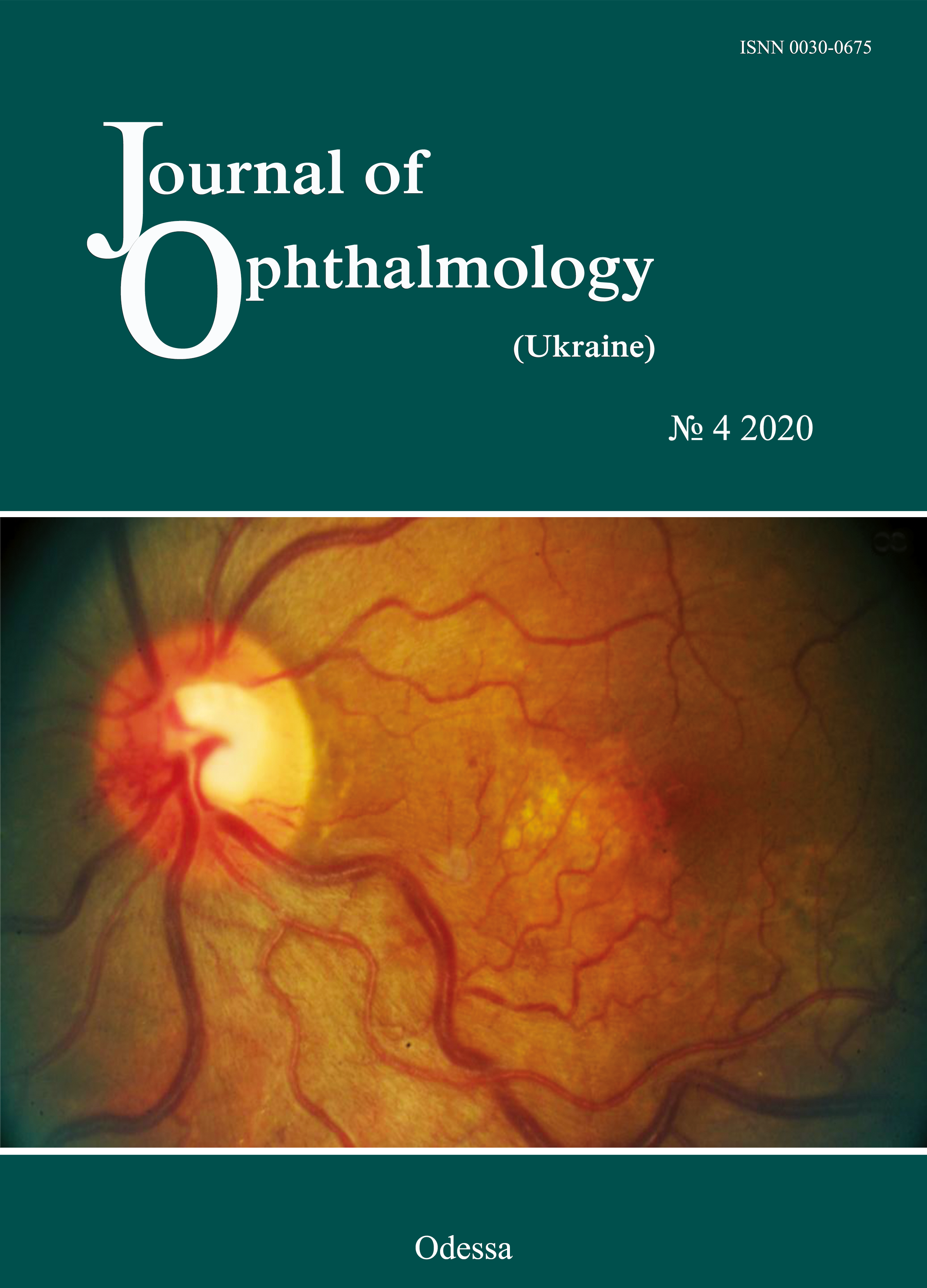Intraventricular hemorrhage as a risk factor for retinopathy of prematurity
DOI:
https://doi.org/10.31288/oftalmolzh2020437Keywords:
retinopathy of prematurity, intraventricular hemorrhage, risk factorsAbstract
Background: Practically any body system in the premature infant is at risk of injuries, with the leading ones being perinatal central nervous system injury and visual system injury.
Purpose: To investigate the incidence of retinopathy of prematurity (ROP) in infants with intraventricular hemorrhage (IVH).
Material and Methods: Eye examination records and neurosonograms of 1249 preterm infants were reviewed. All these infants underwent ROP screening in due time. The fundus was assessed as per the 2005 International Classification of Retinopathy of Prematurity (ICROP). Neurosonograms were performed on days 1 to 4, 10 to 14, and weeks 4 to 8 of life to obtain data on the presence of IVH. Intracranial intraventricular hemorrhage was classified as per ICD-10. In particular, subependymal hemorrhage (without intraventricular extension) was classified as Grade 1, and subependymal hemorrhage with intraventricular extension (bleeding into ventricle) was classified as Grade 2. In addition, subependymal hemorrhage with intraventricular extension with enlargement of ventricle was classified as Grade 3, and subependymal hemorrhage with intracerebral extension was classified as Grade 4. Statistical analyses were performed using MedCalc v.17.4 (MedCalc Software bvba, 1993-2017).
Results: ROP was found in 351 infants. Of these, 65 had stage 1 ROP, 155 had stage 2 ROP, 45 had type 1 pre-threshold ROP, 28 had stage 3 ROP, 25 had threshold ROP, and 33 had aggressive posterior ROP (APROP). No ROP was found in 898 infants. Of the 1249 preterm infants, 609 had neurosonographic findings of IVH, including 406 infants with grade 1 or 2 (i.e., low-grade) IVH and 203 infants with grade 3 or 4 (i.e., high-grade) IVH. No IVH was found in 640 infants. Of the 406 infants with low-grade IVH, 58.4% had no ROP, 6.4% had stage 1 ROP, 16.5% had stage 2 ROP, 6.6% had type 1 pre-threshold ROP, 3.9% had stage 3 ROP, 2.4% had threshold ROP and 5.1% had APROP. Of the 203 infants with high-grade IVH, 63% had no ROP, 3.4% had stage 1 ROP, 20.7% had stage 2 ROP, 6.4% had type 1 pre-threshold ROP, 1.5% had stage 3 ROP, 3.4% had threshold ROP and 1.5% had APROP.
Conclusion: Of the 640 infants without IVH, 82.9% were found to have no ROP, whereas of the 406 infants with low-grade IVH and 203 infants with high-grade IVH, 58.4% and 63%, respectively, were found to have no ROP. Infants with IVH had higher chances for developing ROP (OR=3.2; 95% CI, 2.5-4.2; p < 0.001). Infants with high-grade IVH had higher chances for developing particular stages and forms of ROP (stage 2 and threshold ROP) (OR=2.4; 95% CI, 1.7-3.35; p < 0.05). IVH was found to be a risk factor for developing ROP.
References
1.Makhalev EV. [Clinical and pathological aspects of purulent meningitis in premature newborns with hypoxic injury to the central nervous system]. [Dr Sc (Med) dissertation]. Tomsk (Russia): Siberian State Medical University; 2000. Russian.
2.Nikolaieva GV. [Prevention of retinopathy in premature infants]. [Cand Sc (Med) thesis]. Moscow (Russia): Russian State Medical University; 2000. Russian.
3.Revta AM. [Optimizing monitoring of diagnosis, treatment and outcomes of active retinopathy of prematurity]. [Cand Sc (Med) thesis]. Arkhangelsk (Russia): Northern State Medical University; 2004. Russian.
4.Fedotova S, Adakhovska AO, Zaichko K, Katsan S. [Risk factors for the development of ROP in premature infants]. Oftalmologicheskii zhurnal Kazakhstana. 2017;1-2:69-77. Russian.
5.Volodin NN, Gorelyshev SK, Popov VE, editors. [Intraventricular hemorrhages and posthemorrhagic hydrocephalus in newborns. Principles for providing medical care. Guidelines]. Moscow; 2008. Russian.
6.Brown DR, Giglan AW, Stretavsky MM. Retinopathy of prematurity: the relationship with intraventricular haemorrhage and bronchopulmonary dysplasia. J Pediatr Ophthalmol Strabismus. 1990 Sep-Oct;27(5):268-71.https://doi.org/10.3928/0191-3913-19900901-13
7.King KM, Cronin CM. Ocular findings in premature infants with grade IV intraventricular hemorrhage. J Pediatric Ophthalmol Strabismus. 1993 Mar-Apr;30(2):84-7.https://doi.org/10.3928/0191-3913-19930301-05
8.Leech RW, Kohnen P. Subependymal and intraventricular haemorrhages in the newborn. Am J Pathol. 1974;77:465-75.
9.O'Keefe M, Kafil-Hussain N, Flitcroft I, Lanigan B. Ocular significance of intraventricular haemorrhage in premature infants. Br J Ophthalmol. 2001 Mar;85(3):357-9.https://doi.org/10.1136/bjo.85.3.357
10.Sang GK, Port AD, Ryan S, et al. Retinopathy of Prematurity: A Review of Risk Factors and their Clinical Significance. Surv Ophthalmol. Sep-Oct 2018;63(5):618-637.https://doi.org/10.1016/j.survophthal.2018.04.002
11.An International Committee for the Classification of Retinopathy of Prematurity. The International Classification of Retinopathy of Prematurity Revisited. Arch Ophthalmol. 2005 Jul;123(7):991-9.https://doi.org/10.1001/archopht.123.7.991
12.ICD-10. Chapter XVI. Certain conditions originating in the perinatal period.
13.Lyakh YuE, Guryanov VG, Khomenko VN, Panchenko OA. [Basics of Computer Biostatistics. Data Analysis in biology, medicine and pharmacy statistical using statistical software Med Stat]. Donetsk: Papakitsa EK; 2006. Russian.
14.Jacobson L, Fernell E, Broberger U, Ek U, Gillberg C. Children with blindness due to retinopathy of prematurity: a population based study. Perinatal data, neurological and ophthalmological outcome. Dev Med Child Neurol. 1998 Mar;40(3):155-9.https://doi.org/10.1111/j.1469-8749.1998.tb15439.x
15.Levene MI. Cerebral ultrasound and neurological impairment: telling the future. Arch Dis Child. 1990 May;65(5):469-71.https://doi.org/10.1136/adc.65.5.469
16.Tarby TJ, Volpe JJ. Intraventricular hemorrhage in the premature infant. Pediatr Clin North Am. 1982 Oct;29(5):1077-1104.https://doi.org/10.1016/S0031-3955(16)34248-1
17.Volpe JJ. Neurologic outcome of prematurity. Arch Neurol. Arch Neurol. 1998 Mar;55(3):297-300.https://doi.org/10.1001/archneur.55.3.297
18.Burstein J, Papile L, Burstein R. Subependymal germinal matrix and intraventricular hemorrhage in premature infants: diagnosis by CT. Am J Roentgen. 1997;128:971-6.https://doi.org/10.2214/ajr.128.6.971
19.Bolisetty S, Dhawan A, Abdel-Latif M, et al. Intraventricular Hemorrhage and Neurodevelopmental Outcomes in Extreme Preterm Infants. Pediatrics. 2014 Jan;133(1):55-62.https://doi.org/10.1542/peds.2013-0372
20.Procianoy RS, Garcia-Prats JA, Hittner HM. An association between retinopathy of prematurity and intraventricular haemorrhage in very low birth infants. Acta Paediatr Scand. 1981 Jul;70(4):473-7.https://doi.org/10.1111/j.1651-2227.1981.tb05725.x
21.Hungerford J, Stewart A, Hope P. Ocular sequelae of preterm birth and their relation to ultrasound evidence of cerebral damage. Br J Ophthalmol. 1986 Jun;70(6):463-8.https://doi.org/10.1136/bjo.70.6.463
22.Charles JB, Ganthier R Jr, Appiah AP. Incidence and characteristics of retinopathy of prematurity in low-income inner-city population. Ophthalmology. 1991 Jan;98(1):14-7.https://doi.org/10.1016/S0161-6420(91)32350-9
23.Amato M, Pasquier S, Muralt G. Incidence of retinopathy of prematurity in low birth weight infants with peri-intraventricular haemorrhage. Neuropediatrics. 1986 Nov;17(4):191-2.https://doi.org/10.1055/s-2008-1052527
24.Phillips J, Christiansen SP, Ware G. Ocular morbidity in very low birth-weight infants with intraventricular haemorrhage. Am J Ophthalmol. Am J Ophthalmol. 1997 Feb;123(2):218-23.https://doi.org/10.1016/S0002-9394(14)71039-6
25.Mylonas C, Kouretas D. Lipid peroxidation and tissue damage. In Vivo. 1999 May-Jun;13(3):295-309.
26.Beligere N, Perumalswamy V, Tandon M, et al. Retinopathy of prematurity and neurodevelopmental disabilities in premature infants. Semin Fetal Neonat Med. Oct;20(5):346-53.https://doi.org/10.1016/j.siny.2015.06.004
Downloads
Published
How to Cite
Issue
Section
License
Copyright (c) 2025 С. В. Кацан, А. А. Адаховская, Е. С. Будивская

This work is licensed under a Creative Commons Attribution 4.0 International License.
This work is licensed under a Creative Commons Attribution 4.0 International (CC BY 4.0) that allows users to read, download, copy, distribute, print, search, or link to the full texts of the articles, or use them for any other lawful purpose, without asking prior permission from the publisher or the author as long as they cite the source.
COPYRIGHT NOTICE
Authors who publish in this journal agree to the following terms:
- Authors hold copyright immediately after publication of their works and retain publishing rights without any restrictions.
- The copyright commencement date complies the publication date of the issue, where the article is included in.
DEPOSIT POLICY
- Authors are permitted and encouraged to post their work online (e.g., in institutional repositories or on their website) during the editorial process, as it can lead to productive exchanges, as well as earlier and greater citation of published work.
- Authors are able to enter into separate, additional contractual arrangements for the non-exclusive distribution of the journal's published version of the work with an acknowledgement of its initial publication in this journal.
- Post-print (post-refereeing manuscript version) and publisher's PDF-version self-archiving is allowed.
- Archiving the pre-print (pre-refereeing manuscript version) not allowed.












